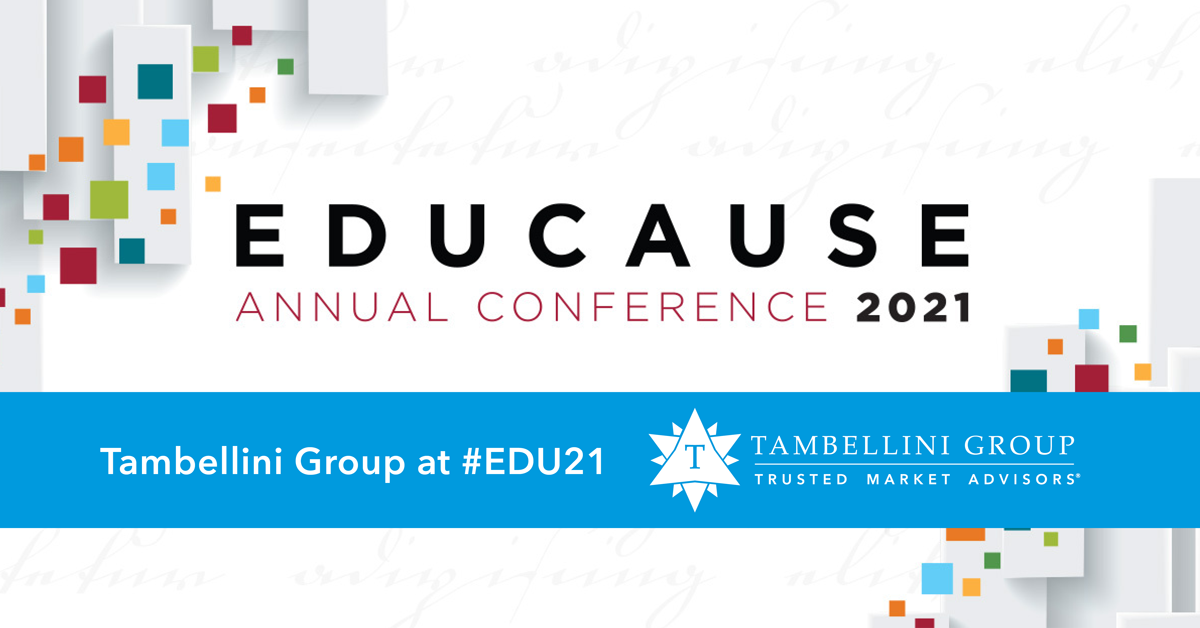Tambellini Takeaways: 2021 EDUCAUSE Annual Conference
Former Analyst
Principal Analyst

The 2021 EDUCAUSE annual conference was held in Philadelphia last week. There were far fewer attendees than usual because of the pandemic, and the small numbers moving through the convention center created an eerie but also intimate effect. Long conversations, deep reflections, hard questions, and honest responses were the norm. These engagements led to our growing conviction that we should all stop talking about the future of higher education in the singular. We agree with our new Senior Analyst D. Christopher Brooks who recently tweeted that COVID-19 was a nexus event for higher education, exacerbating or accelerating the diversification of perspectives, priorities, and needs across the ecosystem.
Higher education is effectively disrupted, although how the disruption will impact the long-term lived experience of individuals within the ecosystem remains to be seen. Nevertheless, despite their increasingly different contexts, we were struck by common threads of concern that institutional leaders expressed. We believe the following Tambellini takeaways from the 2021 EDUCAUSE conference reflect the issues campus IT leaders will face in the upcoming year.
Humanizing the Student Experience
Student experience during the pandemic forced many institutions to acknowledge that narrow definitions of student success are simply not valid. The holistic definitions of success that are currently emerging challenge the notion of academic primacy over student affairs. They also highlight weaknesses across institutional operations, from student support services to data governance and institutional effectiveness. Ethics of care surfaced in multiple EDUCAUSE sessions as institutions began to really consider what student-first learning means. Given the emerging roles of technology in this space, IT leaders must consider how they will leverage their leadership and campus technology to humanize the student experience effectively.
Workforce Retention and Development
Institutions are also reckoning with the humanity of their workforce. Recent articles describe the exhaustion, low morale, and generally poor mental health (and mental health support) for higher education faculty and staff. Many employees are struggling. However, institutions also desperately need them to reskill, upskill, and adapt to new ways of being and doing. Maintaining some level of remote work seems to be the answer for some but not all employees, and many campus leaders are seeking to visualize how new hybrid and remote workspaces might look at their institutions. In 2022, IT leaders will be asked to cultivate people-first policies and practices to support flexibility, enable recovery, and empower growth.
Access, Equity, and Accessibility
COVID-19 brought the widespread inequalities of our society into sharp focus. As such, higher education’s understanding of access, equity, and accessibility is expanding and maturing. All campus stakeholders are responsible for protecting student rights, amplifying student voices, and improving access to everything essential for student success. IT leaders must find ways to provide students with frictionless navigation of institutional systems and easy access to technology, quality Wi-Fi, and support services. They are also prioritizing universal design and accessibility when purchasing campus technologies.
Teaching and Learning
We believe teaching and learning will never be the same at higher education institutions, but our argument does not hinge on the presence or absence of HyFlex learning. We challenge IT leaders to look beyond the HyFlex hype to find better ways to support the growing demands for relevance, inclusivity, and care in the classroom. For most higher education institutions, a single-minded focus on HyFlex technologies is not appropriate for 2022. Flexibility is essential, but it should consist of quality on-ground, online, and hybrid offerings; equity and authenticity in assessment; and faculty excellence in trauma-informed learning and other evidence-based pedagogies.
Student Lifecycle Support
Many higher education institutions require new, integrated processes and technologies to provide comprehensive support for students throughout the lifecycle. Enterprise CRMs contribute to this conversation, as do the new energy around advancement, continuing education, and workforce analytics. However, many student lifecycles are not linear—they are intermittent, iterative, and multi-institutional. As more institutions realize this (and the fact that they can leverage it for financial sustainability), campus IT leaders will be called on to support microcredentialing and continuous learner records, as well as CRM technologies.
Financial Sustainability
The pandemic shook the already threatened financial health of many higher education institutions. Every market segment is facing specific enrollment pressures for various reasons. The national labor shortage has also hit institutions and highlighted the need to improve workforce experience, including wages. Campus IT leaders are faced with tough choices about where and how to invest limited funds. Technology consolidation, shared services, and modernization efforts are trending but exist in tension with the significant upfront costs of digital transformation and next-generation, cloud-based technologies. Transformation cannot happen without adequate staffing, change management, and resources. Therefore, financial risk is top of mind at many institutions making decisions regarding cloud migration and digital transformation.
Identity and Access Management
Cybersecurity remains front and center for higher education, as for most industries. The latest front in this fight is the proliferation of ransomware, which has exposed significant weaknesses in institutional security (and education technology vendors’ security). Many higher education institutions have not implemented the modern identity management practices and technology essential for protecting against ransomware. The homegrown systems that served institutions well in the past are generally insufficient to support the flexibility, onboarding, offboarding, and role-based access demands of today’s institutions. The growing number of SaaS solutions found on campuses only increases the urgency surrounding identity management and governance for many IT leaders.
Finding Value in Institutional Data
Now, more than ever, institutional leaders need answers from campus data—particularly concerning student experience and financial modeling. Real-time analytics and cross-functional reporting are near-universal aspirations, as both are essential to support agile decision-making. New offerings in this space have created a landscape that is uneven and difficult to evaluate. Additionally, many institutions lack the mature data cultures and widespread analytics expertise necessary to optimize their use of next-generation data analytics tools. IT leaders must quicken their pace towards mature data governance and management practices to ensure consistent, reliable, and efficient analytics at scale.
Cloud Migration
Aging data centers, looming infrastructure reinvestments, and requirements for institutional agility drove many institutions towards cloud migration during and immediately after COVID-19. Cloud migration is an opportunity but not a guarantee for digital transformation. Institutions doing it right are gaining agility and capability because they are effectively reevaluating and evolving business processes and cultures as well as changing their technologies.
However, change in higher education is especially difficult, and institutional leaders can falter if they do not plan adequately or have the necessary buy-in across campus. The Tambellini EDUCAUSE panel session with Cal Poly CIO Bill Britton and Embry-Riddle Aeronautical University CIO Becky Vasquez offered examples of cloud migration as digital transformation.
Digital Transformation
The pandemic accelerated many destabilizing trends in higher education, including increased competition, rapid senior leadership turnover, and evolving cultural and political valuation of higher education in our society. Increasingly, campus stakeholders need and expect technology-enabled transformation. IT leaders recognize the need to reconsider and realign institutional priorities.
Because technology has the potential to deliver transformation, the digital transformation moniker is accurate yet wholly inadequate to describe the deep innovation required to support students and the educational enterprise. IT leaders must demonstrate commitment to building and executing a strategy that leverages technologies to inform and enable institutional decisions, practices, and priorities.
Categories
Share Article:

Additional Authors:

Other Posts From this Author:
© Copyright 2025, The Tambellini Group. All Rights Reserved.